Digging the Keweenaw
On Lake Superior, an isolated peninsula yields up all sorts of riches.
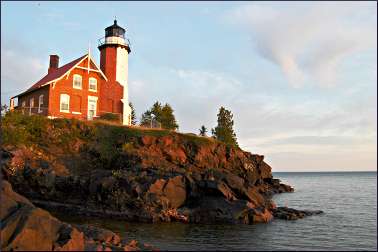
© Torsten Muller
On Michigan's Keweenaw Peninsula, distance is both curse and blessing.
Jutting deep into Lake Superior, it's far from big cities — for Detroit residents, Nashville and Washington, D.C., are closer than the Keweenaw (pronounced KEY-win-awe).
It was "beyond the most distant wilderness and remote as the moon," statesman Patrick Henry told Congress after early mining attempts were abandoned in 1771.
But its deposits of pure copper were the world's largest, and in 1843, a copper rush brought in workers from dozens of nations. By 1913, 60,000 people lived in Calumet, extracting millions of pounds of copper for Calumet & Hecla Mining Co.
But a failed strike that year soured life for workers, and declining demand, low prices and another strike ended the mining era for good in 1968.
Now, the Keweenaw merits only an occasional blip on the national radar.
Backpackers know that Copper Harbor is the jumping-off point for Isle Royale National Park, and park headquarters is in Houghton, a college town that National Geographic Adventure magazine called one of the nation's Top 10 "gateway towns" for summer sports.
Besides hiking on Isle Royale, there's scuba diving to the shipwrecks of the Keweenaw Underwater Preserve, kayaking on the Keweenaw Water Trail and mountain biking on old mining and logging roads around Copper Harbor and Calumet.
But most people come to the Keweenaw simply to explore.
Then, they see why distance is a blessing. There are no condo or townhouse developments, no luxury resorts, no weekend McMansions taking up shoreline.
Instead, there are blueberry patches, wildflowers and quiet beaches. There are twisting roads under canopies of trees. There are villages where working people live, and an 1844 fort where interpreters play working people of the past.
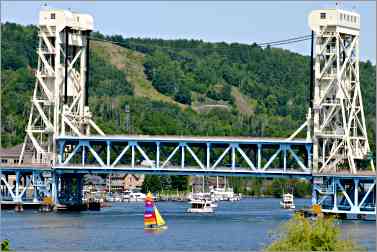
© Beth Gauper
And there are tourists, of course. They visit the 10 lighthouses, tour the mines and cruise along Brockway Mountain Drive, renowned for fall color.
They stop at the Jampot near Eagle River, where the cloaked monks of the Society of St. John do a brisk business in ginger muffins, brownies and oatmeal cookies.
They snap photos of bear cubs ambling along U.S. 41, which follows the high ridge between Calumet and Copper Harbor.
But many of the "tourists" go way, way back.
"We like to ask new people how they found us," says Chris Kvale, who runs the Lake Breeze inn in Eagle Harbor with his wife, Marcia Raley. "It's interesting how many people have connections to Copper Country."
Raley's great-grandfather, Judge William Raley, built a lakefront warehouse in 1859 that his youngest son, Austin, turned into a lodge in 1923.
His son Frank and Frank's wife, Helen, took it over, and their daughter Marcia Raley spent carefree summers there in the '50s and '60s, often joining guest families on their excursions.
Now she and Kvale drive up each summer from their Minneapolis home and open it for appreciative guests, many of whom come back year after year.
"There's a strong sense of place here, an attachment to the land," she says. "People come back for generations."
Most of her father's side of the family, however, joined an exodus that accelerated in the 1920s, when the automotive plants around Detroit began hiring en masse.
"My great-grandfather said to his kids, 'Get out of this place. Mining is dead. Lumber is gone. There are no resources,'"she said. "They all left, except for my grandfather."
The Keweenaw is bustling no longer. But it holds many beauties, including remnants of its industrial past.
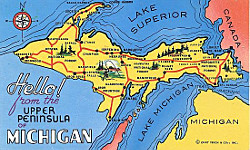
© Beth Gauper
The first thing people see when they crest the hill above Houghton is the giant 1908 shaft house of the Quincy Mine, looming on the opposite hill above Hancock.
Below, the massive, double-deck Portage Lake Lift Bridge crosses the shipping canal that separates the two towns; Keweenaw is an Ojibwe word for "place where one crosses."
From Hancock, the highway winds up the hill past Finlandia University, the nation's only college founded by Finns, and heads toward Calumet. Only a little more than 700 people live there now, plus nearly 2,000 in adjoining Laurium, but many of the stately brick and red sandstone buildings remain.
One of them is the Calumet Theatre, an 1899 opera house that's still a performing-arts showcase, especially during the Pine Mountain Music Festival in the summer.
It's also part of the Keweenaw National Historical Park, along with Coppertown USA mining museum. Inside the museum, exhibits tell how Calumet & Hecla ran the town, building schools, churches, clinics, bathhouses and recreational fields for their employees. It also owned their houses and operated the stores.
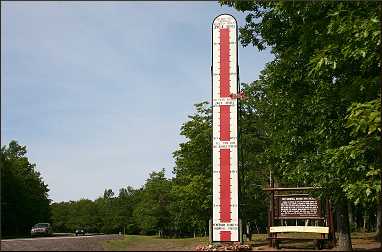
© Beth Gauper
In the schools, it trained students in the skills the company needed. Today, a historical plaque outside Washington School reads "From Minors to Miners."
"The company giveth, but the company also taketh away," said Peter Manzini, who was at the museum showing his grandson a re-creation of the C&H hospital. His father worked briefly in the mines, he said, but then took over an Italian grocery in Calumet.
"They made millions, but they took it all away, those Bostonians," he said. "My father saw to it that no one in the family worked in the mines. It was a terrible life; terrible."
When he grew up, Manzini left Calumet to work in Detroit. But he returned when he retired, drawn by vivid childhood memories of the busy town.
"Oh, things were really going here then," he says wistfully.
Many people come back every year for Calumet's Heritage Celebration. And in Central, a virtual ghost town after the rich Central Mine closed in 1898, descendants of the original Cornish miners have been holding annual reunions since 1907.
The loveliest parts of the Keweenaw are farther north, along the lake. Fog-shrouded Eagle River is the county seat, with an 1866 Greek Revival courthouse rising incongruously amid a meager collection of houses.
Thanks to surveys by state geologist Douglass Houghton, it became the first boomtown in 1845, the same year 37-year-old Houghton drowned in the lake, caught in an open boat by a nor'easter.
Today, tourists come to see Eagle River Falls, watch ore boats from the cobblestone beach and buy fudge and ice cream at the Eagle River General Store, open since 1867.
Seven miles up the road, Eagle Harbor is the peninsula's most charming town, with a classic red-brick lighthouse, built in 1871, and a well-protected harbor lined by a sandy swimming beach.
Father Frederic Baraga stayed at the old general store here, and at the 1853 schoolhouse across the harbor, a young teacher formed a dramatic society that evolved into the Knights of Pythias, a secret fraternity that performed charitable works.
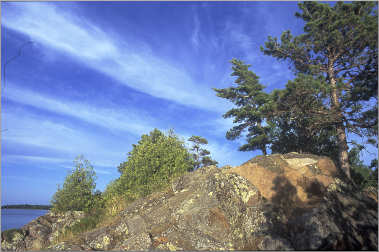
© Beth Gauper
In Eagle Harbor, the luckiest people stay at the 1859 Lake Breeze, which its owners have gracefully brought into the present without sacrificing character.
On the lake, it sits at the edge of the rocky shoreline; around the corner, a long covered porch faces the harbor. Above the entrance, a birch log carries the motto, "Park Your Cares Outside."
Kayaks are parked on the grass, near overflowing flower boxes and '50s-style metal chairs on which guests can watch for the eagles that nest across the harbor. Inside, the aroma of balsam fir fills the tiny lobby, and friends meet beside the fire to play cards or gaze at the lake through picture windows.
Only a small sign at the edge of an unpaved drive points to the 10-room lodge, where a hedge surrounds a small parking area. Raley and Kvale barely advertise, but people find them anyway.
From Eagle Harbor, a two-lane road hugs the lake, passing Agate Beach, Dan's Point and Esrey Roadside Park on its way to Copper Harbor.
In June, the resort village unrolls for tourists, who visit the gift shops, take narrated cruises to the 1866 lighthouse and visit the 1844 fort at Fort Wilkins State Park.
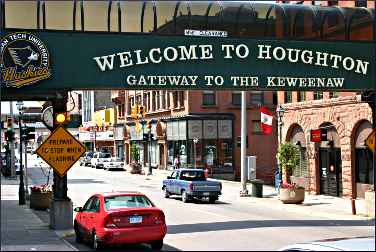
© Beth Gauper
At Fort Wilkins, costumed interpreters play the roles of the military folk who whiled away their days there, sent first to handle Indian hostility and mining strife that never materialized and later to wait out Civil War enlistments.
Some golf on the hilly course at Keweenaw Mountain Lodge, built by the Works Progress Administration in the 1930s, or go hiking in Estivant Pines, a nature sanctuary in virgin forest just outside town.
But the white pines are perhaps more impressive just around the peninsula, where their feathery branches stand out against open sky on the lake-hugging road between Bete Grise and Gay.
Bete Grise has a long public beach, with picnic tables and changing rooms. But people who use the pullouts on the road to Gay and walk down to the shore will have a private beach all their own, complete with blueberry patches, driftwood seating and sand that blends into a red shelf of Jacobsville sandstone that's so soft it rubs off on toes.
Even on summer weekends, there's barely any traffic. For a long time, mining and paper companies owned most of the land, and anyone could use it for berry picking and agate hunting. More of it is up for grabs now, but so far, development has been low-key.
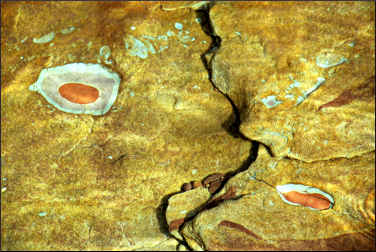
© Beth Gauper
That leaves its treasures intact for people who take the trouble to find them.
"This area, partly because of its remoteness, never has been the place to go," Marcia Raley says. "But the explorers get here."
Trip Tips: Michigan's Keweenaw Peninsula
When to go: By July, the black flies have mostly passed through, and it's warm enough to swim in shallow coves.
In late July and early August, you can pick blueberries and thimbleberries, and bear sightings are likely.
Fall is gorgeous, and there's ample snow in winter for skiers and snowmobilers.
Events: June, Bridgefest in Houghton and Hancock. August, Art Fair in Eagle Harbor. August, Pasty Fest in Calumet. Labor Day weekend, Copper Harbor Trails Festival.
Coppertown Mining Museum: The Calumet museum is open Monday through Saturday from June through September.
Copper Country Trail National Scenic Byway: This 47-mile stretch of U.S. 41 between Houghton and Copper Harbor links the many historical attractions.
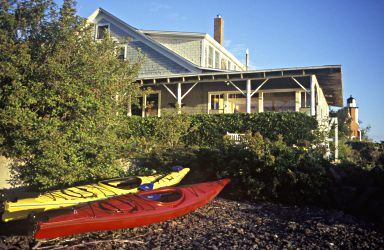
© Beth Gauper
Mine tours: Quincy Mine outside Hancock is open for tours, as is the Delaware Mine, 12 miles south of Copper Harbor.
Fort Wilkins Historic State Park: The campsites are attractive and have free first-come, first-served storage areas for campers heading to Isle Royale.
Costumed living-history interpreters are on site from mid-June to mid-August.
Kayaking: The Keweenaw Adventure Company in Copper Harbor rents kayaks and offers tours, 906-289-4303.
Boat tours: In Hancock, Copper Country Boat Tours offers sunset cruises on the Portage Canal and historical tours.
Nightlife: From mid-June to mid-July, the Pine Mountain Music Festival offers opera, cabaret and classical music at venues in Houghton, Hancock and Calumet.
The Calumet Theatre also hosts vaudeville revues and concerts, 906-337-2166.
Accommodations: In downtown Houghton, the boutique Vault Hotel is in an 1887 former bank building. The Super 8 is well located along the waterway near downtown.
The Lake Breeze in Eagle Harbor has 10 attractive and comfortable rooms, and coffee and muffins are served in the morning. It opens for the Fourth of July weekend, then stays open through August. 906-289-4514.
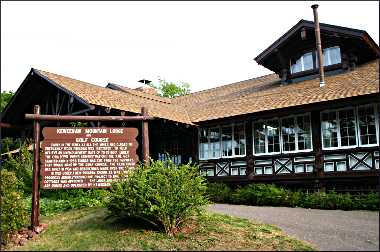
© Beth Gauper
In the hills above Copper Harbor, the handsome log Keweenaw Mountain Lodge rents motel rooms and one- to three-bedroom log cabins, many with wood-burning fireplaces but no kitchens. It has a restaurant.
In Copper Harbor, Lake Fanny Hooe Resort & Campground rents motel rooms, cottages, a chalet apartment unit and campsites.
For more about Copper Harbor, see Copper Harbor refuge.
The Sand Hills Lighthouse Inn is near Ahmeek.
Dining: Good bets include Toni's Country Kitchen in Laurium (for pasties), Glacia Tavern and Slim's Cafe (for pasties) in Mohawk, Fitzgerald's in Eagle River, Eagle Harbor Inn in Eagle Harbor and the Harbor Haus in Copper Harbor. In Calumet, Carmelitas Southwestern Grille is known for its thimbleberry margaritas.
There's also a Pasty Trail with 13 pasty shops.
Craft beer: In Houghton, have a beer and peanuts around the fire in the tap room of the Keweenaw Brewing Company.
You'll also find craft beer at Red Jacket Brewing in Calumet and Brickside Brewery in Copper Harbor.
Between Eagle Harbor and Eagle River, the Jampot is a good place to pick up baked goods. It's open from May through late October (closed Sundays).
Information: Keweenaw tourism, 906-337-4579.